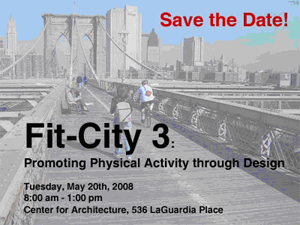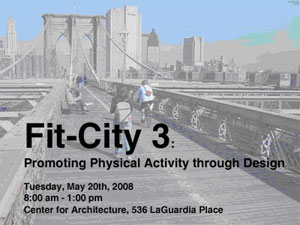by: Bill Millard
Event: Fit-City 3: Promoting Physical Activity through Design
Location: Center for Architecture, 05.20.08
Keynotes: James Sallis, PhD — Prof. of Psychology, San Diego State University and Program Director, Active Living Research; Jan Gehl, Hon. FAIA — architect, public space consultant, Copenhagen, Denmark
Speakers: Comm. Thomas Frieden, MD, MPH — NYC Dept. of Health and Mental Hygiene; Comm. David Burney, FAIA — NYC Dept. of Design and Construction; Rick Bell, FAIA — Executive Director, AIA-NY; Comm. Adrian Benepe, NYC Dept. of Parks and Recreation; Comm. Janette Sadik-Khan — NYC Dept. of Transportation; Alexandros Washburn, AIA — Chief Urban Designer, Dept. of City Planning; Brandon Mitchell — Full Spectrum NYC; Vishaan Chakrabarti, AIA — Related Companies; Stephanie Gelb, AIA — Battery Park City Authority; Robyne Kassen, Assoc. AIA — Pedestrian Studio
Moderators: Asst. Comm. Lynn Silver — NYC DoH; Joyce Lee, AIA — NYC Office of Management and Budget
Organizers: AIANY; NYC Department of Health
Convincing a roomful of urban architects and public-health personnel that too many Americans are unhealthy doesn’t require a raft of statistics. At the third annual Fit-City symposium, Health Commissioner Thomas Frieden, MD, MPH, provided research statistics anyway, as did “obesity warrior” James Sallis, PhD, program director of Active Living Research, and NYC Dept. of Health and Mental Hygiene (DoH) Assistant Commissioner Lynn Silver, whose national maps showed the alarming state-by-state rise of unhealthy body-mass indexes. The nation now has a proportion of overweight citizens once found only in isolated pockets of pudginess. Diabetes, an obesity-related condition, is rising even faster in NYC nationally. Human biology hasn’t changed, several speakers pointed out; people’s environment and diet have. Architects have some control over the former.
Design alone rarely induces sedentary people to exercise, but a coordinated, research-driven public-health effort that combines physical detailing and behavioral prompting — the new catchphrase is “active design” — is conducive to measurable results. One step promoted by Frieden and NYC Department of Design and Construction (DDC) Commissioner David Burney, FAIA, is to simply use stairs rather than elevators or escalators. Floor plans and attention to aesthetics can make staircases easy to find, welcoming, and visibly safe; on the behavioral side, Burney announced a new public education effort: a free poster by DDC’s graphic design division reading “Burn Calories, Not Electricity/Take the Stairs.” Janette Sadik-Khan, NYC Department of Transportation, presented the “Sustainable Streets” master plan, including measures such as car-free-street days, an idea pioneered in Bogotá, Colombia.
The blend of optimism and promotionalism wasn’t confined to the public sector: representatives of two private developers (Vishaan Chakrabarti, AIA, of the Related Companies, and Brandon Mitchell of Full Spectrum) presented their firms’ experience with sustainable, transit-oriented, and mixed-use urban residences whose locations and amenities advocate for improved health.
Because bodily de-conditioning is associated with car dependence, poor air quality, and a shortage of parks and recreational facilities, panelists believed that PlaNYC’s greening measures can produce positive health effects. NYC Department of Parks and Recreation Commissioner Adrian Benepe presented the plan’s components addressing the need to “program parks, not just build them.” Walking and cycling, in particular, enhance the quality of life for nearly the whole population, and keynote speaker Jan Gehl, Hon. FAIA, architect and public space consultant in Copenhagen, offered arguments for a steady effort to “reconquer” urban space for these and other human-scale activities. Gehl’s anecdote of cycling through Copenhagen with his wife on their 45th wedding anniversary, surveying the changes that several decades of public-space advocacy had brought to their home city, drove home the value of fighting this particular fight.
Ninth Avenue has a Copenhagen-style protected bike lane (at least as a seven-block proof-of-concept prototype), but for PlaNYC to move the city effectively toward Copenhagen’s level of civility, it must take on tougher battles. Overcoming the conundrum limiting bike commuting to the least risk-averse population, for example — cycling becomes safer when enough people ride, but most people won’t ride in city streets until they’re convinced it’s safe — requires a broad culture change: drivers have to learn instinctive respect for cyclists, and police must crack down on aggressive drivers. The Fit-City symposium indicates that officials and private players have a clear view of what a healthy built environment looks like, drawing on the world’s best examples and counselors. This vision, more than any single reform, is a major component of progress.
If you would like to learn more about the Fit-City program, AIANY has published pamphlets available at the Center for Architecture that detail symposium discussions.
Bill Millard is a freelance writer and editor whose work has appeared in OCULUS, Icon, Content, The Architect’s Newspaper, and other publications.










